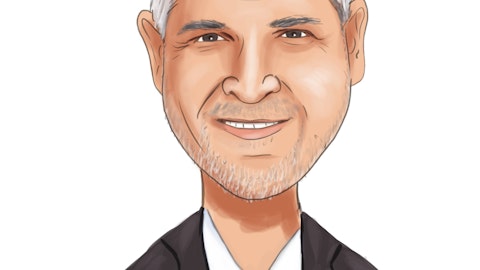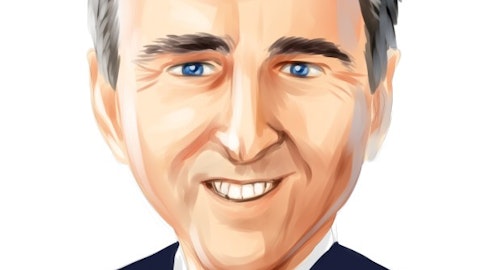Jack Henry & Associates, Inc. (NASDAQ:JKHY) Q2 2023 Earnings Call Transcript February 8, 2023
Operator: Good morning, and thank you for joining us for the Jack Henry Second Quarter Earnings Conference Call. Please note this event is being recorded. I’ll now like to turn the conference over to Mr. Vance Sherard, Vice President of Investor Relations. Please go ahead.
Vance Sherard: Good morning and thank you for joining us for the Jack Henry Fiscal 2023 Second Quarter Earnings Call. Joining me on the call today is David Foss, Board Chair and CEO; Mimi Carsley, CFO and Treasurer; and Greg Adelson, President and COO. After these opening remarks, I will turn the call over to Dave for his thoughts about the state of our business, financial and sales performance for the quarter, industry comments and other key initiatives. After Dave concludes his comments, Mimi will provide additional commentary regarding the financial results and fiscal year guidance included in the press release issued yesterday that is available from the Investor Relations section of the Jack Henry website. We will then open the lines for Q&A.
As a reminder, this call includes certain forward-looking statements, including remarks or responses to questions concerning future expectations, events, objectives, strategies, trends or results. Like any statement about the future, these are subject to multiple factors that could cause actual results or events to differ materially from those which we anticipate due to multiple risks and uncertainties. The company undertakes no obligation to update or revise these statements. For a summary of these risk factors and additional information, please refer to yesterday’s press release and the sections in our 10-K entitled Risk Factors and Forward-Looking Statements. On this call, we will discuss certain non-GAAP financial measures including non-GAAP revenue and non-GAAP operating income.
The reconciliations for non-GAAP financial measures are in yesterday’s press release. I will now turn the call over to Dave.
David Foss: Thank you, Vance. And good morning, everyone. Today, we’re pleased to report another strong quarter of revenue and operating income growth. As always, I’d like to begin today by thanking our associates for all the hard work and commitment that went into producing those results for our second quarter. For Q2 of fiscal 2023, total revenue increased 2% for the quarter, and increased 6% on a non-GAAP basis. This variance was primarily due to a reduction in deconversion revenue, which I’ll detail in a few minutes. Turning to the segments, we again had a solid quarter in the core segment of our business. Revenue was flat for the quarter but increased by 6% on a non-GAAP basis. Our payments segment also performed well posting a 3% increase in revenue this quarter and a 6% increase on a non-GAAP basis.
We had a very strong quarter on our complementary solutions businesses with a 4% increase in revenue this quarter, and an 8% increase on a non-GAAP basis. Yesterday’s press release included revised guidance which Mimi will outline in her comments. One of the key drivers behind this change in guidance was the actual and forecasted reduction in deconversion revenue for the year. As we disclosed yesterday, deconversion fees are down $20 million year-to-date. And this was the primary driver of the variance in GAAP versus non-GAAP revenue and operating income performance for Q2. As a reminder, we receive deconversion revenue when one of our clients is acquired by another institution and is required to pay us a fee to terminate their contract prior to the end date.
I normally referenced this as the revenue you don’t want to see because it indicates we’ve lost a client to M&A. This lack of consolidation by financial institutions is also impacting our services revenue associated with convert and merge activities. Because of the impacts to bank stocks and valuations, M&A is down overall in the banking space, and the experts in the industry don’t see any significant rebound for at least a couple of quarters. Of course consolidation is outside of Jack Henry’s control and we normally update guidance for deconversion revenue as we become aware of pending M&A activity. The other primary item impacting our guidance is the recent change in consumer spending behavior. Due to economic conditions, consumer card usage is slowing and transactions are shifting from debit to credit.
Our card processing business is significantly weighted to debit processing. So we are revising guidance to reflect what we believe to be a temporary economic trend. As I’ve said many times in the past, our financial model is very resistant to significant swings resulting from changes in the overall economy. But we’re not completely bulletproof. Despite the external factors, our primary businesses remain strong and continue to perform very well. As I mentioned in the press release, our sales teams again had an outstanding quarter with a number of notable wins. In fact, Q2 set a new quarterly sales record for Jack Henry breaking the record we set in the June quarter last year. In the second quarter, we inked 12 competitive core takeaways, and an additional 15 deals to move existing in-house core clients to our private cloud environment.
December 30, was a particularly memorable day for us to Jack Henry as we signed the three core takeaways of multibillion dollar financial institutions on the same day. We continue to see good success with our new card processing solution, signing 12 new card processing clients this quarter. We also continue to see great success signing clients to our Banno digital suite with 36 new contracts in Q2. Speaking of our digital suite, our Banno business solution is scheduled to go into general release next quarter. We already have 18 institutions live in early adopter status with the feedback being extremely positive from those users. We have 308 clients under contract for the solution, and we’re positioned to bring them into full production at a very rapid pace once we achieve general availability.
We are also continuing to implement new financial institution clients on the retail Banno platform at a similar pace to recent quarters. At the end of Q2, we surpassed 8.8 million registered users on the platform, and Banno continues to hold one of the highest consumer ratings in the App Store. Normally in January, I share with you the results of bank spending survey projections from the publications we follow closely. Unfortunately, this year, none of those major publications provided forward looking projections around the topic of expected tech spending in the banking segment. I have received a number of smaller surveys, and we conducted our own informal survey at a banking CEO roundtable last month with the results being all relatively consistent.
The average increase appears to be settling at around 7% for calendar 2023, with the most popular range being a 5% to 10% increase. I’ll continue to watch for firm objective data and we’ll share as it becomes available. As you may have noticed last month, we took a major step forward with our environmental efforts by signing a commitment letter indicating our intention to set science-based climate targets with the Science Based Targets Initiative or SBTI. Science Based Targets are aligned with the level of decarbonization necessary to meet the goals of the Paris agreement to limit global warming to 1.5 degrees Celsius above pre industrial levels. Jack Henry will pursue validation for near term greenhouse gas emissions reduction targets through SBTI.
This commitment follows extensive analysis and discussion and is supported by our low carbon transition plan which outlines several mitigation tactics to reduce our greenhouse gas emissions. More information regarding this plan will be disclosed in our next sustainability report, which will be released on March 31 through the investor site on Jack henry.com. As you will recall, it was on this call last year that we announced our new technology monetization strategy. We developed this multiyear strategy to help us deliver the public cloud native capabilities to Community and Regional financial institutions, allowing them to innovate, compete and meet the evolving needs of their account holders. We are continuing to make great progress on the strategies four main objectives.
First, we’re redefining the core processing system by unbundling services that traditionally would be in the core and building them as standalone modules on the public cloud. In September, we announced plans to build these services on the Google Cloud. And we’ve been testing our wire processing and authorization management services modules on the Google Cloud since that time. We currently have six clients live in early adopter status with domestic wires, and plan to offer general availability for this solution in July. We expect to launch the international wire solution for early adopters in April and expect that module to be generally available late in the fourth calendar quarter this year. Second, we’re working to provide multiple data integration options utilizing our open philosophy and technology.

Photo by David Dvořáček on Unsplash
Our newest offering in this area is real time data streaming, simultaneous, constant streaming of necessary data to all systems on the platform. We’re currently in beta with real time data streaming, which is essential to support real time payments and fraud detection. We expect this functionality to go into live production later in this calendar year. Delivering industry leading capabilities across a single next generation platform is the third objective. Banno was a key element in this part of the strategy. But we’re working on several other additional solutions to build upon this commitment. As an example, in September, we added Payrailz, a public cloud native digital payments platform to our suite of payment solutions. Additionally, this summer we’re launching Financial Crimes defender, our next-gen Financial Crimes platform with enhanced capabilities, including machine learning, and artificial intelligence.
This new fraud solution has been built entirely on our public cloud native platform. The last step in the strategy is to move from acting as a core processor to offering a full banking ecosystem. This includes our own capabilities, plus access to leading fintechs through a single platform that prioritizes openness, agility, speed, and optionality. A year ago, I announced that we had more than 850 FinTech providers in our ecosystem, today is closer to 950 and the number continues to grow. We’re also the only platform provider that has relationships with all four major financial data aggregators, Finicity, Plaid, Yodlee, and Akoya. Through these companies, financial institutions can give account holders a complete financial picture in a safe secure manner that eliminates screen scraping.
We’ve seen strong interest in this strategy from both prospects and customers. Anecdotally, I can tell you that we are currently in conversations with a number of prospects, who have indicated that the technology modernization strategy I just described is the primary driver for them to engage with Jack Henry to help develop their technology strategy for the future. Community and Regional financial institutions are the lifeblood of mainstream America. Many of them, however, are at a crossroads. The personal service and experience they are known for is being disrupted by technology as nontraditional financial service providers have entered the market. And the way people bank has fundamentally changed especially for the younger generation. As a well-rounded financial technology company, Jack Henry is in a unique position to provide modern technology and services to help community and regional financial institutions capitalize on this opportunity and strengthen connections with their account holders.
The key takeaway is that while we’re successfully meeting the needs of our clients today, as shown by our performance results, we’re also preparing them for the future. We’re pleased with the progress we’ve made on this exciting strategy. And we’ll share more updates at our Investor Day in May. As we began the second half of our fiscal year, our sales pipeline is very robust, and we continue to be optimistic about the strength of our technology solutions, our ability to deliver outstanding service to our clients, our ability to expand the client relationships, the spending environment, and our long-term prospects for success. With that, I’ll turn it over Mimi Carsley for some detail on the numbers.
Mimi Carsley: Thanks, Dave. Good morning, everyone. As highlighted by Dave’s comments, Jack Henry had a successful second quarter and I will discuss the details driving those results. Total revenue is up 2% for the quarter on a GAAP basis and solidly up 6% on a non-GAAP basis. Fiscal year-to-date, GAAP revenue was up 5% and non-GAAP revenue increased 7%. So let’s jump into the details. on a GAAP basis services and support revenue decreased 2% in the second quarter, but increased 3% year-to-date. Services and support were negatively impacted as deconversion revenue decreased $21 million for the quarter, $20 million year-to-date. This is consistent with the broader market lack of acquisition activity in our space. We now anticipate approximately $15 million in deconversion revenue this fiscal year.
However, forecasting deconversion revenue remains challenging given the limited advance notice and the general uncertain nature of M&A. Our private and public cloud offerings showed robust growth this quarter, growing 11% and 10% year-to-date. Product delivery and services decreased 26% in the quarter, impacted by lower deconversion fees and convert merge activity offset by slightly higher implementation related revenue. As a reminder, user group conference related to a major customer conference shifted into Q1 this year contributing to the year-over-year Q2 revenue decline. Year-to-date, product delivery and services revenue decreased 11% influenced by similar drivers as the quarter. On a non-GAAP basis, services and support revenue grew 6% for the quarter, and 7% year-to-date, which serves to highlight our consistently fundamental business stress.
Processing revenue increased 9% on a GAAP basis for both the quarter and year-to-date. On a non-GAAP basis, the growth was 7% for the quarter, and 8% year-to-date, the increases were largely driven by higher card volumes, despite a slight increase in the rate of growth. Additionally, digital revenue continues to show rapid growth led by robust demand for Banno Digital platforms. Now turning to cost, cost of revenue was up 8% for both the quarter and year-to-date. Quarterly drivers included increased card processing costs consistent with card revenue growth, higher personnel costs, and amortization expense. These drivers are consistent across our year-to-date results. Research and development expense increased 22% for the quarter, mostly due to higher personnel costs and licensing fee.
Year-to-date, these expenses increased 23% based on the same factors. SG&A was 2% driven by increases in personnel, travel, professional services, partly offset by the gain on sale of assets. Year-to-date, the increase was 7% influenced by similar drivers. The quarter and the remainder of the year benefit from disciplined focus and actions involving facility rationalization, headcount and travel control, procurement wins and other expense management. These collective efforts help to offset inflationary pressures and mitigate lower revenue. As we previously mentioned, some compensation and travel related cost increases result from the lower cost comparisons from our first half of fiscal 2022. Due to previously mentioned management rigor on cost controls, we concluded Q2 with strong operational results.
Despite net income declining 16% primarily due to deep lower deconversion fees and increased interest expense, the quarter saw a fully diluted earnings per share of $1.10. Our GAAP and non-GAAP results for the quarter and year-to-date are consistent with internal expectations and set us up for a strong finish to fiscal year €˜23. As a reminder, for transparency, the impact from the gain on the sale of assets, including this quarter sale of an Albuquerque property, yielding a $1.2 million gain to Payrailz acquisition and deconversion fees are shown as part of non-GAAP adjustments in the press release. Turning our attention to cash flow. Operating cash flow was $191 million for the year-to-date down from $197 million for the same period last year, essentially due to lower deconversion revenue.
Total R&D investment remain slightly elevated, which should normalize by next fiscal year. Free cash flow which is operating cash flow less CapEx and cap software less proceeds from the sale of assets was $119 million. We remain committed to maintaining ample operating liquidity, reinvesting for growth, evaluating financially sound strategic acquisitions, paying dividends, and opportunistically repurchasing our stock. This consistent dedication to value creation resulted in a trailing 12 month return on invested capital of 21.4%. Focusing ahead, let me discuss updated guidance. The press release included revised GAAP and non-GAAP full year guidance. The GAAP guidance remains inclusive of Payrailz acquisition, gain on asset sales and deconversion fees.
We expect the trends impacting Q2 results to continue for the remainder of the fiscal year impacting both GAAP and non-GAAP results. Most significantly, assuming minimal industry consolidation, deconversion fees will likely remain muted at approximately $15 million for the fiscal year, representing a $20 million decrease from our previous guidance. Second, languishing bank M&A related consolidation negatively impacted our outlook for our convert merge services revenue for the fiscal year. As a reminder, this revenue is driven by our clients acquiring and implementing Jack Henry solutions at their newly purchased institution. Finally, in line with announced payment network activity, we’re experiencing a slower rate of growth and anticipated for debit transaction volumes in our card processing business, primarily driven by a combination of lower consumer spending and the spending shift to credit card.
As a reminder, card processing is approximately 22% of our total revenue. And as Dave highlighted more heavily weighted to debit card business. As a result of these impacts, GAAP revenue growth for fiscal €˜23 is now expected to be 5.4% to 5.8%. Guidance for non-GAAP revenue growth is now 7% to 7.3%. Outlook full year GAAP operating margin is now approximately 22.9%, which is negatively impacted by the expected lower deconversion fees and is inclusive of the impact from both gain on sale of assets and the Payrailz acquisition. Full year non-GAAP operating margin guidance due to strong management expense control is now expected to deliver slightly margin improvement for the fiscal year compared to previous guidance of flat to slightly down.
The management team remains focused on returning to margin expansion in fiscal €˜24. Full year GAAP EPS guidance is now a range of $4.79 to $4.83. The midpoint of $4.81 is an $0.11 decrease from previous guidance, even though those lower deconversion fees drive the $0.20 reduction. The headwind caused by lower deconversion fees is mitigated by the team’s collaborative and disciplined cost control, gain on sale of assets and lower net income. We expect the remainder of fiscal year €˜23 quarterly non-GAAP revenue growth momentum to deliver increases in both in the third and fourth quarters to achieve our revised full year guidance targets. We anticipate similar growth patterns for non-GAAP operating margin delivering the revised increased full year guidance.
So in closing, we delivered another quarter of strong operational and fiscal result and remain solidly optimistic about the success of our business model. We thank all of our investors for their continued confidence in Jack Henry. Keith, will you please open the call for questions.
See also 15 States with Highest Tax Revenue per Capita and 15 Most Undervalued Small-cap Stocks To Buy.
Q&A Session
Follow Jack Henry & Associates Inc (NASDAQ:JKHY)
Follow Jack Henry & Associates Inc (NASDAQ:JKHY)
Receive real-time insider trading and news alerts
Operator: The first question comes from Vasundhara Govil with KBW.
Vasundhara Govil: Hi, thank you for taking my question. I guess the first question on just the non-GAAP revenue weakness, it seems like most of that is basically related to the payment segment with more shift from debit to credit spending. Any changes anticipated in any other segments based on what you were thinking before? And then Dave, just for you. Any update on macro, I know you’re sort of still seeing good momentum in new client signs. But has anything changed in the quarter in terms of bank decision making for new deals? Whether it’s taking more time to close deals or the size of deals that you were seeing just any update there would be super helpful.
David Foss: I’ll take the second part first, Vasu, and then I’ll turn it over Mimi. As far as the overall macroenvironment, I would say things are continuing to look very strong. Our pipeline, I just mentioned in my prepared remarks that we set another sales record in Q2 which I was not expecting, given the huge performance we saw in Q4, the June quarter last year. So to set another overall sales performance record was a surprise to me. But the environment is very strong, the pipeline is larger than it’s ever been. I would say that on the core side of the business, we are trending larger. So I highlighted, we assigned three-multibillion-dollar institutions on December 30th alone, core takeaways December 30th. And I think the if you look at the core side of the business, the accounts that we’re currently involved in are definitely trending larger, bigger institutions coming to Jack Henry looking to make a change.
I certainly believe part of that is driven by the technology modernization strategy. They’re looking for that partner that will really help them modernize. But I think the other driver for that is just the reputation Jack Henry has for delivering great technology and great service. So I would characterize the overall environment for us as far as sales is very strong right now. And as I said in my prepared remarks, although we don’t have any of the big surveys that I can quote, because nobody has published results. I have a whole bunch of more anecdotal bits of feedback and that CEO roundtable that I hosted two weeks ago in Phoenix, and they’re the kind of average spend increase for calendar €˜23 and this is them knowing that their budgets are in place for ’23 already.
So it’s them quoting to me what they have planned, the average was around 7%, as far as an expected spend increase. And by the way, this CEO forum that I hosted was not just Jack Henry core customers. This was a variety of CEOs from a variety of, who are running a variety of different solutions. So that would be my comment on the overall and I’ll turn it over Mimi, to answer your first part of your question.
Mimi Carsley : Thanks, Vasu, for the question. I would say on a non-GAAP revenue change. Yes, I think you’re right in terms of predominantly is around card which is based on that we were optimistic in terms of now the slowing consumer is a little bit slower than we anticipated. And so I think that’s led to a modest deceleration of growth, but still an attractive growth rate, I would call out. And so it’s predominantly around cards.
David Foss: I think that’s important to emphasize that our growth rate year-over-year is for the payments business is very strong. Now we’ve backed off a little bit because what’s happening in consumer behavior, but we should not lose sight of the fact that the payments business is up significantly year-over-year as far as overall growth.





